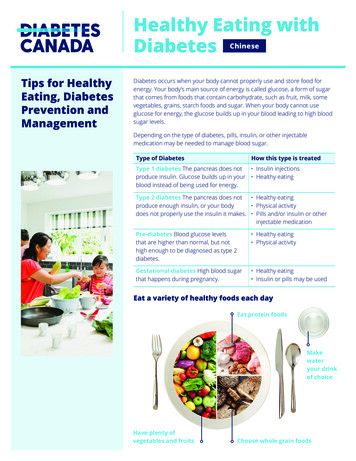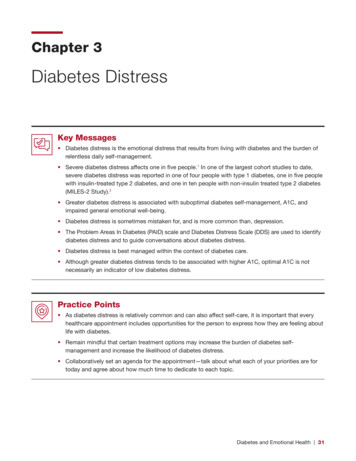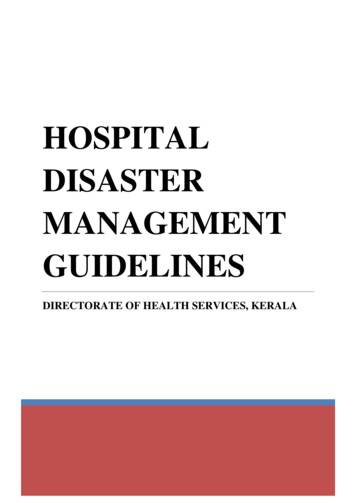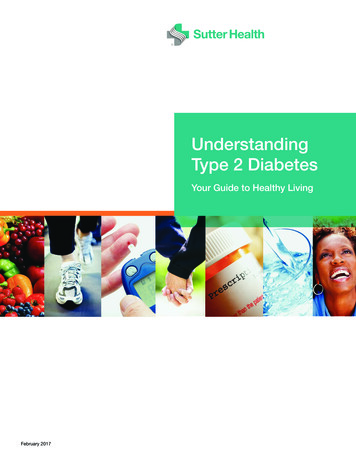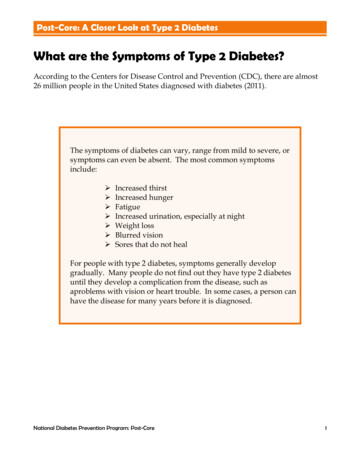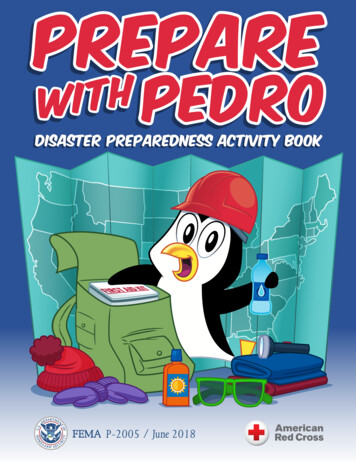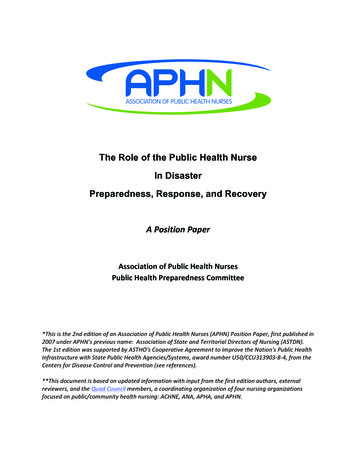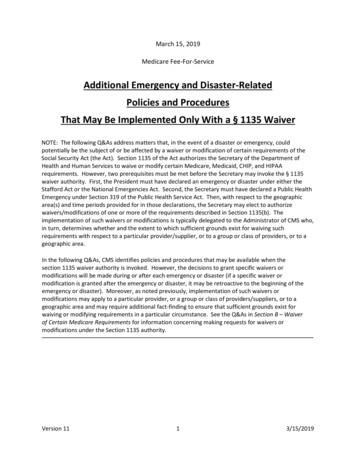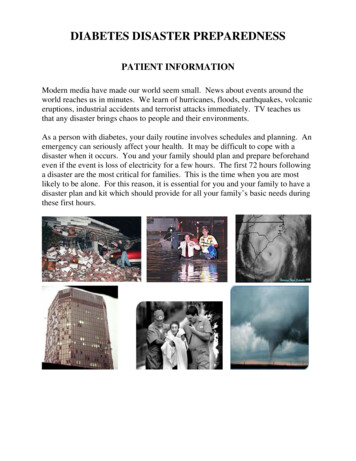
Transcription
DIABETES DISASTER PREPAREDNESSPATIENT INFORMATIONModern media have made our world seem small. News about events around theworld reaches us in minutes. We learn of hurricanes, floods, earthquakes, volcaniceruptions, industrial accidents and terrorist attacks immediately. TV teaches usthat any disaster brings chaos to people and their environments.As a person with diabetes, your daily routine involves schedules and planning. Anemergency can seriously affect your health. It may be difficult to cope with adisaster when it occurs. You and your family should plan and prepare beforehandeven if the event is loss of electricity for a few hours. The first 72 hours followinga disaster are the most critical for families. This is the time when you are mostlikely to be alone. For this reason, it is essential for you and your family to have adisaster plan and kit which should provide for all your family’s basic needs duringthese first hours.
BE PREPARED LISTYou should safely store the following medical supplies or have them readilyavailable:""""""""""""""""Copy of your emergency information and medical listExtra copies of prescriptionsInsulin or pills (include all medications that you take daily including overthe counter medications)SyringesAlcohol swabsCotton balls & tissuesA meter to measure blood sugarBlood sugar diaryInsulin pump supplies (if on insulin pump)Strips for your meterUrine ketone testing stripsLancing device and lancetsQuick acting carbohydrate (for example, glucose tablets, orange juice, etc.)Longer lasting carbohydrate sources (for example, cheese and crackers)Glucagon Emergency Kit (if on insulin)Empty hard plastic detergent bottle with cap to dispose used lancets andsyringesOther supplies:Flashlight with extra batteriesWhistle/noisemakerExtra pair of glassesFemale sanitary suppliesHeavy work glovesToolsFoodRadio with extra batteriesPad/pencilMatches / candlesFirst-aid kitCopy of health insurance cardsImportant family documentsWaterClothing and beddingCell phoneMake sure you have enough supplies for 2 weeks.These supplies should be checked at least every 2 – 3 months.Watch for expiration dates.
HELPFUL HINTS ABOUT INSULIN, PENS, SYRINGESo Insulin may be stored at room temperature (59 - 86 F) for 28 days.o Insulin pens in use can be stored at room temperature according tomanufacturer’s directions.o Insulin should not be exposed to excessive light, heat or cold.o Regular and Lantus insulins should be clear.o NPH, Lente, Ultralente, 75/25, 50/50, and 70/30 insulins should beuniformly cloudy before rotating.o Insulin that clumps or sticks to the sides of the bottle should not be used.o Although reuse of your insulin syringes is not generally recommended, inlife and death situations, you have to alter this policy. Do not share yourinsulin syringes with other people.
THINGS TO REMEMBERStress can cause a rise in your blood sugar.Erratic mealtimes can cause changes in your blood sugar.Excessive work to repair damage caused by the disaster (without stopping forsnacks) can lower your blood sugar.Excessive exercise when your blood sugar is over 250mg can cause your bloodsugar to go higher.Wear protective clothing and sturdy shoes.Check your feet daily for an irritation, infection, open sores or blisters. Disasterdebris can increase your risk for injury. Heat, cold, excessive dampness andinability to change footwear can lead to infection, especially if your blood sugar ishigh. Never go without shoes.HOT WEATHER TIPS Stay indoors in air-conditioned or fan cooled comfort.Avoid exercising outside.Wear light colored cotton clothing.Remain well hydrated (water, diet drinks).Avoid salt tablets unless prescribed by your physician.Seek emergency treatment if you feel:Fatigue, weakness, abdominal crampsDecreased urination, fever, confusion.You should wear diabetes identificationAT ALL TIMES
FOOD ITEMS TO BE STORED"""""""""""""""1 large box unopened crackers (saltines)1 jar peanut butter1 small box powdered milk (use within 6 months)1 gallon or more of water per day per person for at least one week2 6-pack packages cheese and crackers or 1 jar soft cheese1 pkg. dry, unsweetened cereal6 cans regular soda6 cans diet soda6-pack canned orange or apple juice6 pack parmalat milk6 cans “lite” or water packed fruit1 spoon, fork and knife per personDisposable cups4 packages of glucose tablets or small hard candies for low blood sugar1 can tuna, salmon, chicken, nuts per personMechanical can openerThese supplies should be checkedand replaced yearly.
FOOD CONSIDERATIONS DURING A DISASTER1.Food and water supply may be limited and/or contaminated. Do not eat foodyou think may be contaminated. It may be necessary to boil water for 10minutes before use.2.Drink plenty of water.3.Maintain your meal plan to the best of your ability. Your plan shouldinclude a variety of meat/meat substitutes (i.e., peanut butter, dried beans,eggs), milk/milk products, fruits, vegetables, cereal, grains.4.Limit sugar/sugar-containing foods. These foods include: Jellies, jams, molasses Honey Syrups (fruits canned in sugar syrup, pancake syrup) Tonic (dietetic tonics with less than one calorie per ounce are allowed) Frosted cake Presweetened or sugar-coated cereals Pie, pastry, Danish pastry, doughnuts Chocolate Custards, pudding, sherbet, ice cream Gelatin Soda Cookies, brownies5.Monitor your blood sugars frequently and record in diary.LIMITSWEETS
FOOD CONSIDERATIONS DURING A DISASTER(continued)6.When reading labels, limit products with these sugar-containing ingredients: Sugar Corn syrup Dextrose Sucrose Corn sweeteners Honey Molasses Brown sugar Fruit syrup7.Avoid greasy, fried foods.8.Try to eat meals and snacks at the same time every day. Avoid periods ofhunger and overindulgence. The quantity and frequency of your food intakeshould remain similar day-to-day depending upon your activity level.9.Increase food and water intake during periods of increased exertion orphysical activity by either eating between-meal snacks before activity or byeating additional food with meals.10.Carry a fast source of sugar with you at all times: 3 glucose tablets1 small box of raisins6-7 small hard sugar candies
SICK DAY RULES DURING A DISASTER1.Always take your insulin or pills on time or close to it. Never omit yourinsulin unless your doctor has told you otherwise. Insulin is still good ifthere is no refrigeration. A used or unused bottle of insulin may be kept atroom temperature (59 - 86 F) for 28 days. Discard unrefrigerated insulinafter 28 days.2.Keep an extra bottle of each type of insulin you use on hand at all times.3.Eat within 15 min. or no later than ½ hour after taking your insulin(depending on insulin type) or diabetes medicine. Try to eat on time.4.Never skip a meal. If you cannot eat solid food because of nausea,vomiting, and/or diarrhea, sip regular coke, eat hard candies, fruit orregular soft drinks instead of following your usual meal plan.5.Most Important: Do not let yourself get dehydrated. Drink plenty of liquids. In between meal times, sip diet soda.(This will not replace food, but can help you be hydrated.)6.Rest.7.Check your blood sugar. Notify your doctor if your blood sugar average isover 240mg or if you are ill for 2 days.8.Test your urine for ketones when: Your blood sugar average is over 240mg. You are vomiting You have symptoms of high blood sugar (increased thirst or hungerthan usual, quick weight loss, increased urination, very tired, stomachpain, breathing fast or fruity breath smell).
SICK DAY RULES DURING A DISASTER(continued)9. Call your doctor if your ketone test is moderate or high and/or if youhave symptoms of high blood sugar (as listed in number 8). You mayneed more than your usual amount of insulin on a sick day. Your doctorcan guide you in this.If you need medical assistance / or are out of all medications, food, and cannotreach your doctor, immediately: Go to the nearest hospital; orContact the police; orContact the American Red Cross; orGo to an Emergency Medical Center
1. Always take your insulin or pills on time or close to it. Never omit your insulin unless your doctor has told you otherwise. Insulin is still good if there is no refrigeration. A used or unused bottle of insulin may be kept at room temperature (59 - 86 F) for 28 days. Discard unrefrigerated insulin after 28 days. 2.

